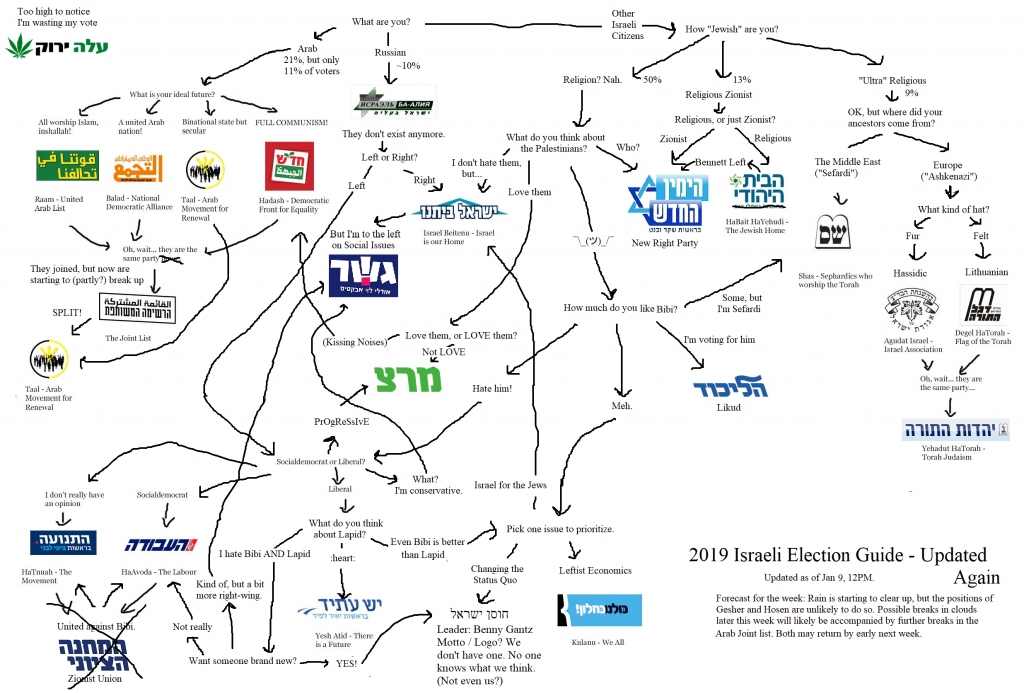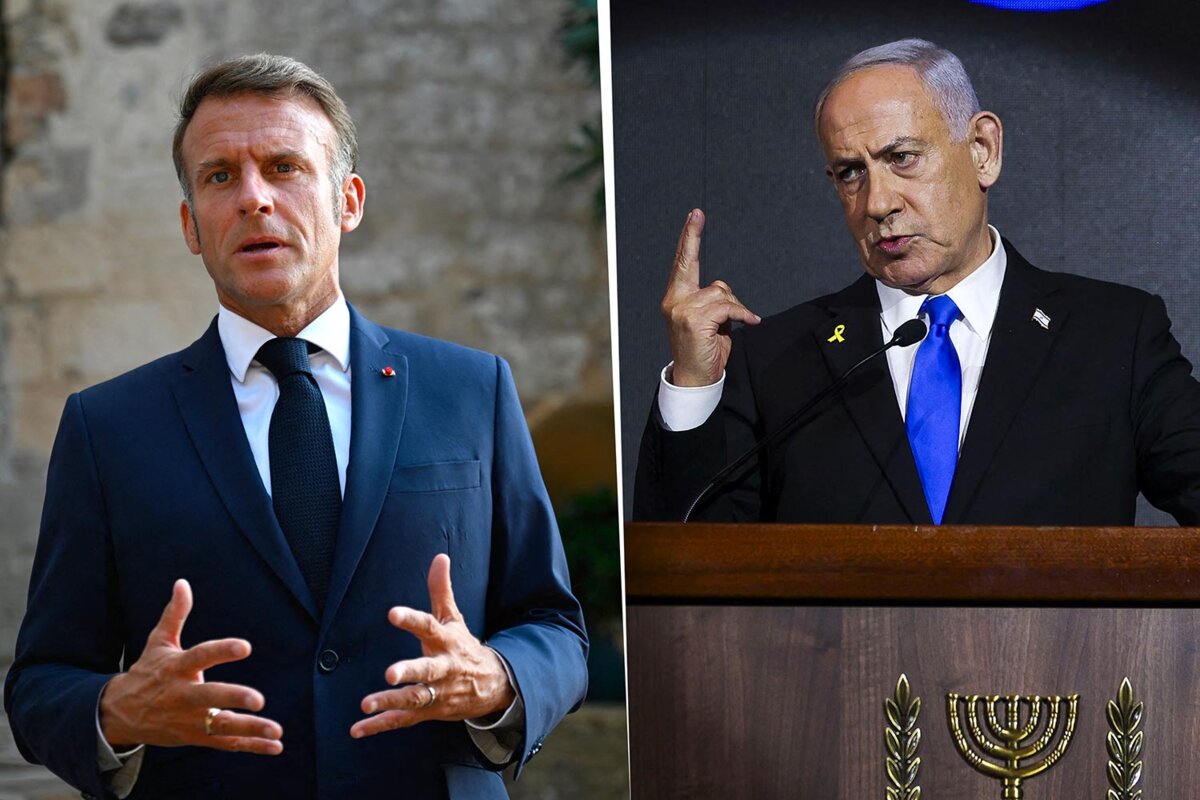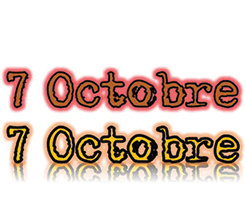Dans un article publié le 11 février dans Haaretz, Chemi Shalev décrit les 10 combinaisons politiques qui pourront infléchir les élections du 9 avril.
Nous le reproduisons intégralement:
Benjamin Netanyahu has to reach two thresholds in order to be re-elected as prime minister on April 9. The first is for his right-wing bloc, otherwise known as his “natural coalition” of nationalist and religious parties, to reach a majority of 61 in the Knesset. The second is for Likud to emerge from the election as the largest single party in the Knesset, ensuring that Netanyahu is picked by President Reuven Rivlin to form the next government.
If Likud comes in second, some of the weaker links in Netanyahu’s bloc could refrain from recommending him to the president. Rivlin, who is no fan of Netanyahu, is then likely to give the nod to the leader of the larger party, who could theoretically entice elements of Netanyahu’s coalition to bolt the prime minister and form a more centrist coalition instead.
These two elements – largest single party and overall Knessetmajority – are the driving forces behind the myriad political maneuvers and machinations that are currently consuming Israeli politics. They will continue unabated over the next 10 days, until the end of business on February 21, the last date for the parties to submit their lists of candidates for the Knesset.
The complication is that the achievement of one goal could come at the expense of the other. The more successful Netanyahu is in prying right-wing voters away from Likud’s satellites on the right in order to ensure Likud’s primacy, the greater the chances that some of them might not pass the threshold of 3.25 percent of the votes, thus hobbling chances for an overall right-wing majority.
The same is true of Netanyahu’s opponents: The more Benny Gantz emerges as the prime minister’s only viable rival, the more he attracts votes from left-wing parties, rendering them vulnerable to parliamentary death by threshold as well.
The prospect of falling by the wayside is pushing the smaller parties on both left and right to contemplate their own mergers and acquisitions, thus increasing their chances of passing the threshold.
Which explains the unusual degree of uncertainty in the political arena. Ten days before the submission of their Knesset lists, eight weeks before the election, Israeli voters have no idea what parties will compete in the April 9 ballot. The possibilities are plenty, but the main ones are listed below.
On the left
1. The Big Bang: A Gantz-Lapid matchup is likely to have the most dramatic effect on voters’ preferences. It could attract moderate right-wingers unhappy with Netanyahu and would instill renewed hope and energy in the center-left, enticing voters to abandon their previous loyalties in order to maximize the chances for Netanyahu’s defeat. Polls show that while a Gantz-Lapid match up would still have to struggle in order to prevent the right-religious bloc from achieving an overall majority, it could very well emerge as the biggest single party, likely ensuring, as mentioned above, that its leader – presumably Gantz – would get first crack at forming a new coalition.
2. The Little Big Bang: Predictions of the prospective success of a centrist bloc headed by Gantz and Lapid are predicated, among other things, on the assumption that its creation would compel former Chief of Staff Gabi Ashkenazi to join his counterparts Gantz and his right-wing partner Moshe Ya’alon, in what would inevitably be dubbed “a party of ramatkalim,” the Hebrew acronym for military chiefs. Abroad, it would be likened to a junta.
But even if the Gantz-Lapid merger falls through, as seems probable now, Ashkenazi could still decide to join Gantz and Ya’alon. The addition of the popular Ashkenazi, could enthuse centrist voters even without Lapid, whose Yesh Atid party would then face an uphill battle maintaining it current size of nine lawmakers.
3. Itsy-Bitsy Bang: The most likely scenario of all would see Gantz team up with Orly Levy-Abekasis, the daughter of former Foreign Minister David Levy, who broke away from Avigdor Lieberman. Such a union would provide Gantz’s party with a much-needed social and economic veneer, with the caveat that Levy-Abekasis’ appeal in the polls has been on a steady decline
4. Deep Left Field: The gallop to Gantz is already hurting both Labor and Meretz on his left, which are both hovering perilously close to the threshold. A Gantz-Ashkenazi-Lapid alliance would compound their predicament.
The result is growing grassroots pressure in both parties to merge, ignoring Labor leader Avi Gabbay’s staunch objections. The turbulence inside Labor is expected to increase after Monday’s party primaries, when Labor candidates will no longer fear their leader’s wrath.
It is unlikely, but not unthinkable, that progress on the informal and unauthorized contacts for a merger with Meretz would lead to Gabbay’s abdication and his last-minute replacement. In fact, prospects for such a scenario, however slim, are the reason that some of Gabbay’s bitterest critics are calling for the merger with Meretz in the first place.
5. Tzipi Tours: Another development that could push out Gabbay, or at least humiliate him, is the triumphant return of his nemesis Tzipi Livni. Despite Gabbay’s demeaning expulsion of Livni live TV, Labor stalwarts are pushing for the former foreign minister to return in order to distance Labor from the threshold.
At the same time, a Livni matchup with Gantz – which could make Labor’s position terminal – isn’t out of the question either.Gantz previously ruled out joining forces with Livni for fear it would cast his party as too leftist and thus incapable of prying away votes from the right. But after Ya’alon joined Gantz and instilled two right-wing stalwarts in the first top 10 of Gantz’s Hosen L’Yisrael party, the former chief of staff may find that he has lurched too far to the right, risking the support of his leftist and center-left voters. Livni, who isn’t as left as her opponents try to portray her, could be the antidote.
6. Lighting Strikes – Again: Waiting in the wings is Ehud Barak, whose surname means lightning in Hebrew. The former prime minister hasn’t positioned himself over the past year as the most vociferous and biting critic of Netanyahu for pleasure alone. A master of long-term strategy, Barak is banking on last minute panic in Labor, including the collapse of Gabbay’s leadership and moves to bring Livni back into the fold, in the hope that he will be recruited as its last-minute savior.
Another alternative is for Barak and Livni to go it alone, with the possible addition of former Likud finance minister and staunch Netanyahu critic Dan Meridor. Such a group, however, would fight in the same center-left arena as Labor, Lapid and Gantz, promising disappointing returns for all.
An unlikelier scenario is for Barak to join Gantz, further identifying Gantz’s party with former army commanders, but this could repel Ashkenazi, with whom Barak has had a running feud since their joint acrimonious service as defense minister and chief of staff at the end of the last decade.
7. Jews and Arabs United: The dissolution of the Joint List of Arab parties, which could still be reversed, has sparked calls on the deep left for an unprecedented merger between Meretz on the Zionist edge of the left and Arab lawmaker Ahmad Tibi’s Ta’al party, which is on the parallel “right-wing” edge of anti-Zionism. Tibi, who initiated the split from the Joint list, is the most popular Arab politician among Israeli Jews.
Both parties would come under fierce criticism for teaming up with “the enemy,” but might also generate first-of-its-kind excitement among leftist Jews and moderate Arabs. Chances for such a merger are remote, but if it happens nonetheless, the ramifications for future Jewish-Arab cooperation would be nothing less than revolutionary.
On the right
8. Likud Large: Netanyahu’s party enjoys a commanding lead in the polls and is under no objective pressure to incorporate others. Nonetheless, the perennially paranoid Netanyahu, who suspects Rivlin will use any opportunity to unseat him, is anxious to ensure the Likud’s predominance.
In recent weeks Netanyahu has floated an alliance with Habayit Hayehudi, the party abandoned by Naftali Bennett and Ayelet Shaked, in order to attract religious right-wingers and undercut both in the process. He has now cooled to the idea, after seeing polls showing that the addition would not add to Likud’s overall share of the vote.
9. Right On: At the same time, however, and as explained above, Netanyahu has good reasons to worry about Likud satellites failing to pass the threshold. Before contemplating its addition to Likud, Netanyahu pressed Habayit Hayehudi to not only renew its decade-long alliance with National Union to its right but to incorporate the arguably Kahanist – i.e. racist – Otzma Yehudit party as well. Newly elected Habayit Hayehudi leader Rafi Peretz, however, is opposed to merging with Otzma – he has even expressed a willingness to join a Gantz-led coalition. Talks between his party and National Union have floundered over the latter’s demand that its charismatic leader and right-wing firebrand Betzalel Smotrich head the list, rather than consign the role automatically to Peretz and Habayit Hayehudi. But most observers expect the sides to reach agreement before the February 21 deadline.
10. Ultra-Orthodox Divided: Another potential threat to Netanyahu’s right-wing majority comes from the Sephardi ultra-Orthodox Shas party, whose voters have abandoned it in favor of more decidedly right wing and less religious parties. The danger that Shas may not pass the threshold has spurred pressures on Shas to join with the Ashkenazi United Torah Judaism party, but its leader Arye Deri seemed to rule out such a merger at the launch of Shas’ election campaign on Sunday night.
With Deri, however, as with most other politicians, it’s always wise to never say never. Their calls for unions, as well as their adamant opposition to them, should not be taken at face value but as posturing and playing hardball. Which means that anything is still possible, including any or all of the above combinations as well as others that will surprise everyone.
Source: Haaretz







